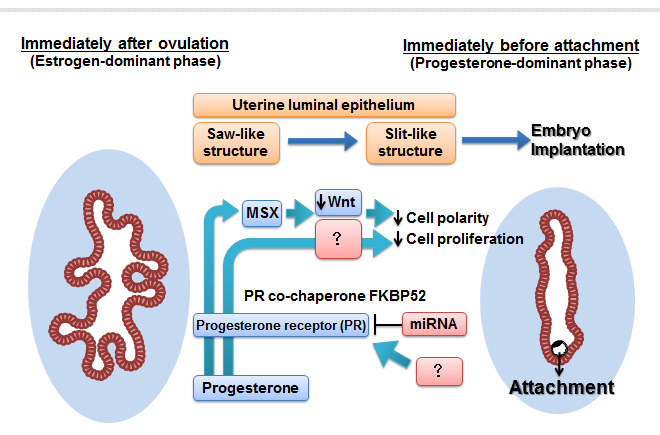|
HOME > Proposed research projects > 2014-2015: Proposed research projects 12
 2014-2015: Proposed research project 12Molecular mechanisms of uterine luminal formation during embryo implantation
Purpose of the Research ProjectBlastocysts can attach to the uterus only when the uterus acquires a limited window of receptivity. Although an ovarian steroid hormone progesterone regulates proliferation and differentiation of various uterine cell types in a spatiotemporal manner to determine the window of uterine receptivity for implantation, the detailed mechanisms by which a uterus achieves receptive capacity remain unclear. In mice, uterine lumens show slit-like structures and epithelial cells transit from a columnar to cuboidal configuration just before embryo implantation, and the disruption of these epithelial structures by deleting progesterone receptor co-chaperone FKBP52 or homeobox transcription factor MSX reveals implantation failure, suggesting that appropriate uterine luminal structures enable embryos to implant normally. The aim of this project is to clarify novel molecular pathways regulating uterine luminal formation during embryo implantation. Content of the Research ProjectOvarian progesterone suppresses cell proliferation of the uterine luminal epithelium, reduces epithelial cell integrity and apical-basal polarity, and alters uterine luminal structures in the pre-implantation period. To identify how progesterone controls uterine luminal structures, we propose to examine the mechanism of progesterone-induced structural formation of uterine luminal epithelium by using several gene-altered mouse models with implantation failure, such as mice with deficiency of FKBP52 and MSX. Based on the findings from these mouse studies, we also use human endometrial cells and tissues to assess the involvement of similar molecular mechanisms in human pregnancy and infertility. Expected Research Achievements and Scientific SignificanceIt is a novel challenge in the field to clarify the relationship between the uterine luminal formation and the receptivity to embryos, and the idea has been harbored by our previous works. The expected achievement of this study is the better understanding of normal and abnormal intrauterine environments from the aspect of uterine luminal structures. Pregnancy rates remain low in patients undergoing IVF-ET due to the transfer of embryos into a non-receptive uterus, resulting in implantation failure. One of the ultimate goals in this project is to discover a new therapeutic approach to implantation failure and the other is to develop novel contraceptives.
|








